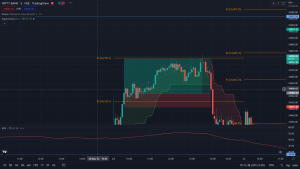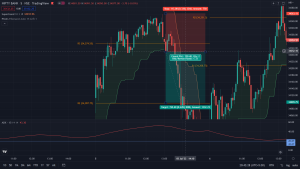

Often many traders get confused between system trading and discretionary trading. There are different trading styles, and the trading style which is suitable for me may not be suitable for you. So you have to see which trading style suits you the most.
In today’s article, we are going to understand what system trading is and how it works and also I will give you one trading system which I have already shared with all of you through my YouTube channel.
System Trading is a trading style in which you define some set of rules for yourself, and you follow them with 100% discipline. No matter what happens in the market, if your system is giving a buy signal, then you have to buy and vice versa.
One major advantage of system trading is you don’t need unnecessary data points which are not considered in your system. For example, let’s say you have made your trading system, and that system has 3 conditions or rules. Now when those three conditions get satisfied, you have to execute your trading; it doesn’t matter whether the overall market is bullish or bearish or India Vix is falling or rising unless it is not a part of your system.
The rules you set for yourself in system trading must be well backtested under different conditions, and you should be able to execute them well. There are various profitable trading systems present over the internet, but their success rate depends upon your execution and discipline. One more important thing one needs to understand here is you must feel comfortable psychologically while executing your trading system in order to increase the success rate. Unless you are not comfortable with your system, no matter how good the system is, you always end up making a loss.
Often traders get confused between System Trading and Discretionary Trading. Discretionary Trading involves human input or human decision-making ability, while system trading does not require any decision-making ability.
Both of these trading styles are unique in their own way. System Trading requires a lot of backtesting and research, while Discretionary Trading requires good price action knowledge and experience. Along with these two trading methods, there is also another trading method which we can call it as System Trading, with a little bit of discretion involved.
In this trading method, most of the rules are pre-defined, but there are some factors that involve human decision-making. This discretion in System Trading will work in your favour and create an additional edge or against you depending on how well you analyse other factors and make decisions based on them.
-This strategy is already shared on my YouTube channel, so If you want to see its practical application, you can click here.
Indicators used in this strategy are-
1) Average Directional Index. (Use on 5 min timeframe but in ADX settings set ADX timeframe to 15min)
2) Supertrend
3) Pivot Fibonacci (Setting change> Standard to Fibonacci)
Rules –
Rule 1 – Check whether ADX is above 20; if yes, then move to rule 2. Else, don’t take the trade.
Rule 2 – Look what super trend is indicating,
If Buy, then take only Long entries.
If sell, take only sell entries.
Rule 3- Look for pivot points
If ADX is above 20, Supertrend is indicating Buy, and there is a fresh breakout from Pivot, take the entry and set stop-loss below the recent price action.
If ADX is above 20, Supertrend is indicating sell, and there is a fresh breakdown from Pivot; take the entry and set stop-loss above the recent price action.
Rule 4 – If 50% gets done, shift your stop-loss just below your entry pivot to reduce the risk and set a target of a minimum 1 pivot.
Rule 5 – Take a maximum of 2 trades in a day.
Here are a few examples of this strategy-
Example 1- Buy Example

In this example, the Value of ADX is around 44, so condition 1 gets satisfied.
Also, there is a fresh pivot breakout from R2, and the Super trend is indicating a buy signal. So, all conditions are satisfied and stop loss is set just below the breakout candle. ( In this case, the tight stop loss is placed because there are back-to-back 3 green candles, and if we place the stop loss below the swing low, then the Risk-Reward ratio gets screwed.)
Example 2 – Sell Example

In this example, the Value of ADX is 23, there is a breakdown from Pivot, and the Super trend indicates a sell signal. So, all conditions are satisfied, and stop-loss can be set at the previous swing high.
So, this is the strategy you can use in Nifty as well as in Banknifty. This strategy has a good win rate and also offers a good risk-to-reward ratio. I hope that this article taught you about system trading and also the difference between System Trading and Discretionary Trading.
If you like this article, don’t forget to share it with your trader friends so that they can also learn about the System Trading and the strategy I gave you in this article.
If you want to know more about Risk Management & Intraday Trading Strategies you can refer to our previous blog on
Importance Of Risk Management In Trading and 10 Best Intraday Trading Strategies.
Open a Demat Account using our link to get support from us – https://bit.ly/3gyhIWN and send your ID to [email protected]
Thanks sir to giving the great knowledge sir you and your strategy are always super
Thank you, Aadesh, glad that you find the blog helpful. We constantly try to bring helpful blogs for our traders and will continue doing so.
Please make a proper series of futures and how to trade futures while maintaining risk to reward
It will be very helpful
So helpful content espically for new traders..I strongly believe this that if we just only follow booming bulls and work on it then we can do best….thank you so much anish sir..
Thank you, Amarjeet, glad that you find the blog helpful. We constantly try to bring helpful blogs for our traders and will continue doing so.
Best sir
Sir i want to join your Instagram
You can follow us here: https://www.instagram.com/boomingbulls/
I will back test and try to apply.
Thank you, Hemant, glad that you find the blog helpful. We constantly try to bring helpful blogs for our traders and will continue doing so.